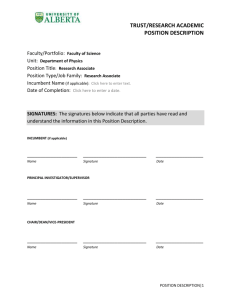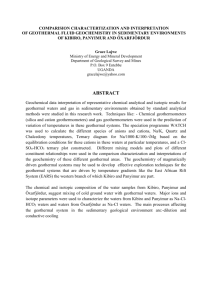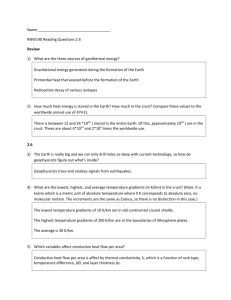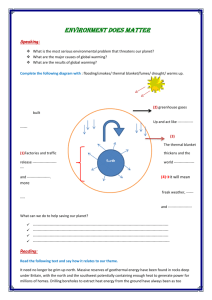What Is Geothermal Energy?
advertisement
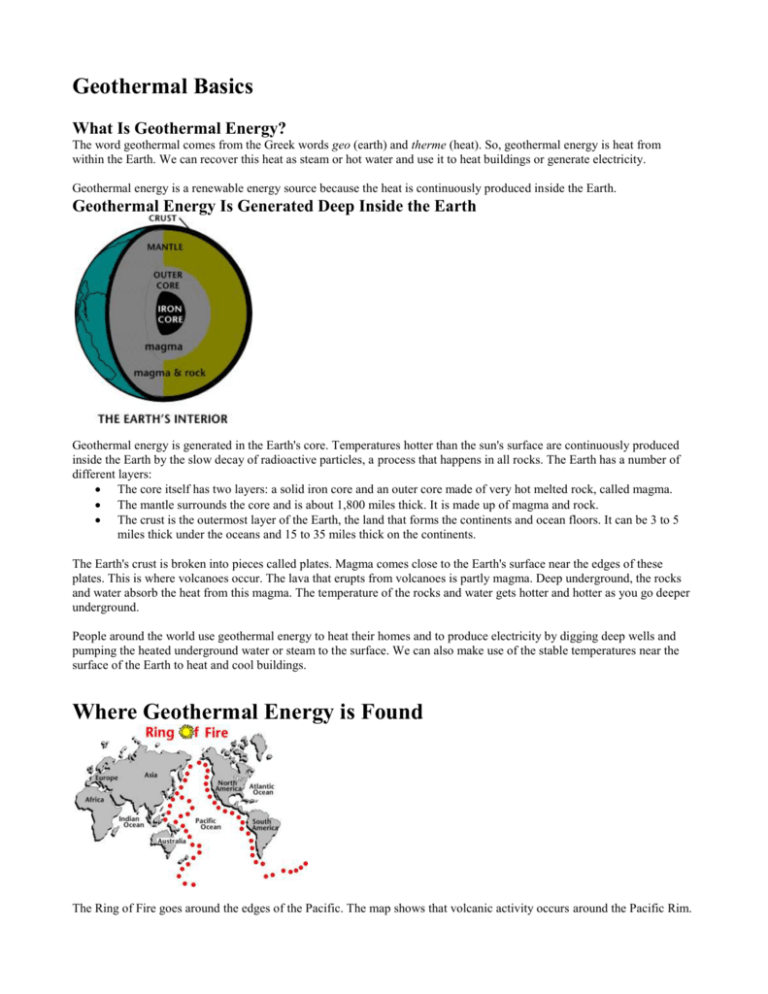
Geothermal Basics What Is Geothermal Energy? The word geothermal comes from the Greek words geo (earth) and therme (heat). So, geothermal energy is heat from within the Earth. We can recover this heat as steam or hot water and use it to heat buildings or generate electricity. Geothermal energy is a renewable energy source because the heat is continuously produced inside the Earth. Geothermal Energy Is Generated Deep Inside the Earth Geothermal energy is generated in the Earth's core. Temperatures hotter than the sun's surface are continuously produced inside the Earth by the slow decay of radioactive particles, a process that happens in all rocks. The Earth has a number of different layers: The core itself has two layers: a solid iron core and an outer core made of very hot melted rock, called magma. The mantle surrounds the core and is about 1,800 miles thick. It is made up of magma and rock. The crust is the outermost layer of the Earth, the land that forms the continents and ocean floors. It can be 3 to 5 miles thick under the oceans and 15 to 35 miles thick on the continents. The Earth's crust is broken into pieces called plates. Magma comes close to the Earth's surface near the edges of these plates. This is where volcanoes occur. The lava that erupts from volcanoes is partly magma. Deep underground, the rocks and water absorb the heat from this magma. The temperature of the rocks and water gets hotter and hotter as you go deeper underground. People around the world use geothermal energy to heat their homes and to produce electricity by digging deep wells and pumping the heated underground water or steam to the surface. We can also make use of the stable temperatures near the surface of the Earth to heat and cool buildings. Where Geothermal Energy is Found The Ring of Fire goes around the edges of the Pacific. The map shows that volcanic activity occurs around the Pacific Rim. Naturally occurring large areas of hydrothermal resources are called geothermal reservoirs. Most geothermal reservoirs are deep underground with no visible clues showing above ground. But geothermal energy sometimes finds its way to the surface in the form of: Volcanoes and fumaroles (holes where volcanic gases are released) Hot springs Geysers Most Geothermal Resources Are Near Plate Boundaries The most active geothermal resources are usually found along major plate boundaries where earthquakes and volcanoes are concentrated. Most of the geothermal activity in the world occurs in an area called the Ring of Fire. This area encircles the Pacific Ocean. U.S. Geothermal Resource Map When magma comes close to the surface, it heats ground water found trapped in porous rock or water running along fractured rock surfaces and faults. These features are called hydrothermal. They have two common ingredients: water (hydro) and heat (thermal). Geologists use various methods to look for geothermal reservoirs. Drilling a well and testing the temperature deep underground is the most reliable method for finding a geothermal reservoir. U.S. Geothermal Power Plants Are Located in the West Most of the geothermal power plants in the United States are located in the western states and Hawaii, where geothermal energy resources are close to the surface. California generates the most electricity from geothermal energy. "The Geysers" dry steam reservoir in northern California is the largest known dry steam field in the world and has been producing electricity since 1960. Use of Geothermal Energy Some applications of geothermal energy use the Earth's temperatures near the surface, while others require drilling miles into the Earth. The three main uses of geothermal energy are: Direct use and district heating systems use hot water from springs or reservoirs near the surface. Electricity generation power plants require water or steam at very high temperature (300° to 700°F). Geothermal power plants are generally built where geothermal reservoirs are located within a mile or two of the surface. Geothermal heat pumps use stable ground or water temperatures near the Earth's surface to control building temperatures above ground. Direct Use of Geothermal Energy There have been direct uses of hot water as an energy source since ancient times. Ancient Romans, Chinese, and Native American cultures used hot mineral springs for bathing, cooking, and heating. Today, many hot springs are still used for bathing, and many people believe the hot, mineral-rich waters have natural healing powers. After bathing, the most common direct use of geothermal energy is for heating buildings through district heating systems. Hot water near the Earth's surface can be piped directly into buildings and industries for heat. A district heating system provides heat for 95% of the buildings in Reykjavik, Iceland. Industrial applications of geothermal energy include food dehydration, gold mining, and milk pasteurizing. Dehydration, or the drying of vegetable and fruit products, is the most common industrial use of geothermal energy. The United States Is the Leader in Geothermal Power Generation The United States leads the world in electricity generation with geothermal power. In 2012, U.S. geothermal power plants produced about 17 billion kilowatt-hours (kWh), or 0.4% of total U.S. electricity generation. In 2012, six states had geothermal power plants: California had 36 geothermal power plants, which produced about 80% of U.S. geothermal electricity. Nevada had 21 geothermal power plants, which produced about 16% of U.S. geothermal electricity. Utah had two plants, and Hawaii, Idaho, and Oregon each had one geothermal plant. Geothermal Contributes Significant Share of Power Generation in Several Countries Twenty four countries including the United States had geothermal power plants in 2010, which generated a total of about 63.9 billion kWh. The Philippines was the second largest geothermal power producer after the United States at 9.4 billion kWh, which equaled about 16% of the country's total power generation. Iceland, the 7th largest producer at 4.3 billion KWh, produced 26% of its total electricity using geothermal energy. Geothermal Power Plants A Geothermic Power Station Geothermal power plants use hydrothermal resources that have two common ingredients: water (hydro) and heat (thermal). Geothermal plants require high temperature (300°F to 700°F) hydrothermal resources that may come from either dry steam wells or hot water wells. We can use these resources by drilling wells into the Earth and piping the steam or hot water to the surface. Geothermal wells are one to two miles deep. Types of Geothermal Plants There are three basic types of geothermal power plants: Dry steam plants use steam piped directly from a geothermal reservoir to turn the generator turbines. The first geothermal power plant was built in 1904 in Tuscany, Italy, where natural steam erupted from the Earth. Flash steam plants take high-pressure hot water from deep inside the Earth and convert it to steam to drive the generator turbines. When the steam cools, it condenses to water and is injected back into the ground to be used over and over again. Most geothermal power plants are flash steam plants. Binary cycle power plants transfer the heat from geothermal hot water to another liquid. The heat causes the second liquid to turn to steam which is used to drive a generator turbine. Geothermal Heat Pumps Using the Earth's Constant Temperatures for Heating and Cooling While temperatures above ground change a lot from day to day and season to season, temperatures 10 feet below the Earth's surface hold nearly constant between 50° and 60°F. For most areas, this means that soil temperatures are usually warmer than the air in winter and cooler than the air in summer. Geothermal heat pumps use the Earth's constant temperatures to heat and cool buildings. They transfer heat from the ground (or water) into buildings in winter and reverse the process in the summer. A Type of Geothermal Heat Pump System Geothermal Heat Pumps Are Energy Efficient and Cost Effective According to the U.S. Environmental Protection Agency (EPA), geothermal heat pumps are the most energy efficient, environmentally clean, and cost effective systems for temperature control. Although most homes still use traditional furnaces and air conditioners, geothermal heat pumps are becoming more popular. In recent years, the U.S. Department of Energy and the EPA have partnered with industry to promote the use of geothermal heat pumps. Geothermal Energy & the Environment The environmental impact of geothermal energy depends on how it is being used. Direct use and heating applications have almost no negative impact on the environment. Grand Prismatic Spring, Yellowstone National Park, Wyoming Geothermal Power Plants Have Low Emission Levels Geothermal power plants do not burn fuel to generate electricity, so their emission levels are very low. They release less than 1% of the carbon dioxide emissions of a fossil fuel plant. Geothermal plants use scrubber systems to clean the air of hydrogen sulfide that is naturally found in the steam and hot water. Geothermal plants emit 97% less acid rain-causing sulfur compounds than are emitted by fossil fuel plants. After the steam and water from a geothermal reservoir have been used, they are injected back into the Earth. Many Geothermal Features Are National Treasures Geothermal features in national parks, such as geysers and fumaroles in Yellowstone National Park, are protected by law, to prevent them from being disturbed.


